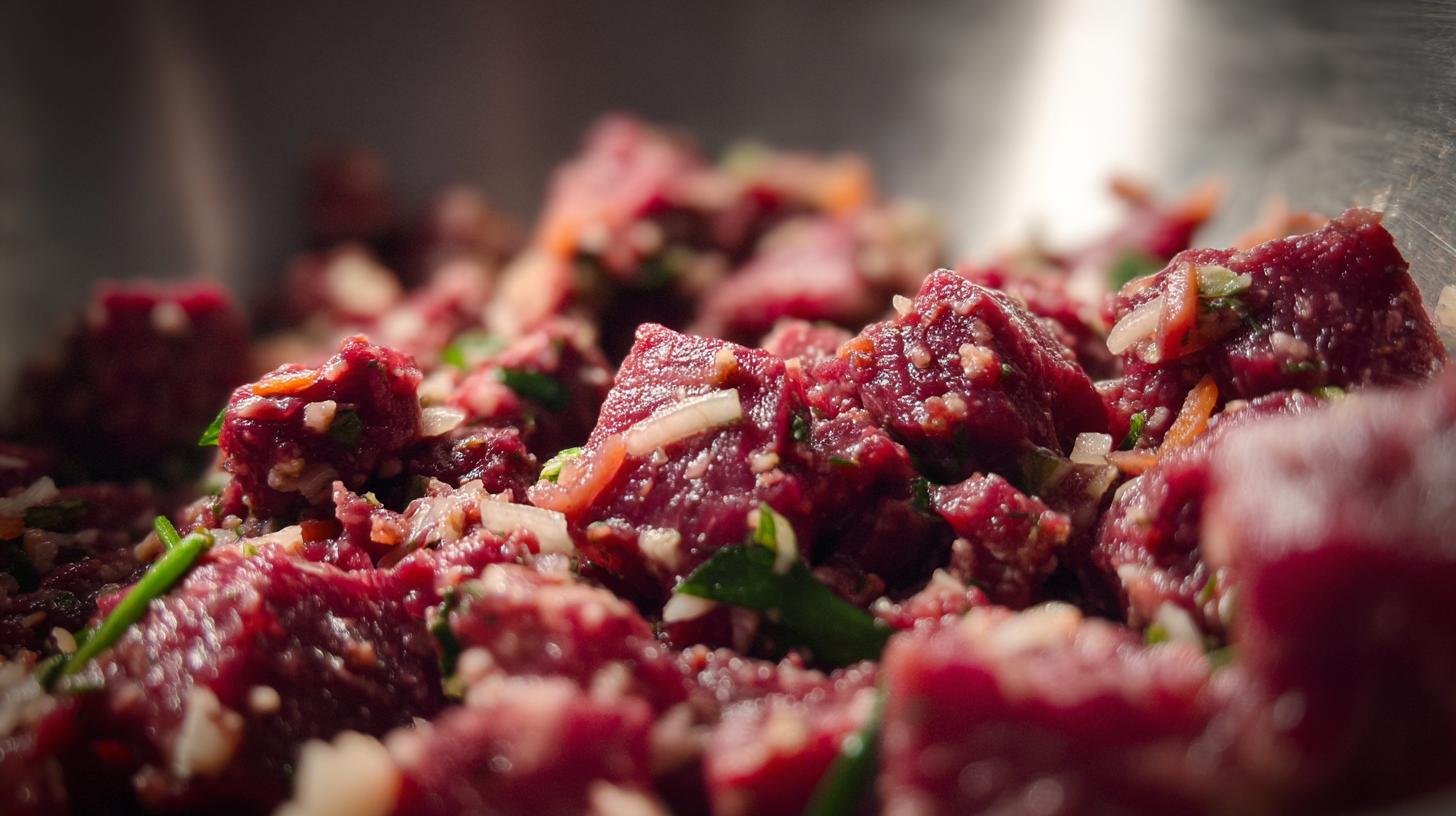When I first started raw feeding my dog, I had no idea how much it would change her energy, coat, and even her mood. She went from sluggish and itchy to downright bouncy—with a glossy coat I couldn’t stop petting. That’s when I really began to explore the nutrients in raw feeding and why they matter so much. Feeding pets real, unprocessed food—like fresh meats, raw bones, and organs—closely mimics what their ancestors ate in the wild. It’s not just trendy; it’s biologically appropriate and packed with the good stuff they need to thrive.
Over the years, I’ve learned a lot about canine nutrition through hands-on experience, research, and working alongside a holistic vet. I’m no scientist, but I’m a passionate home cook—and when it comes to feeding our furry family members, I believe they deserve the same care we give ourselves. If you’re curious or overwhelmed, don’t worry—I’ll walk you through it, step by step, just like I did when I started.
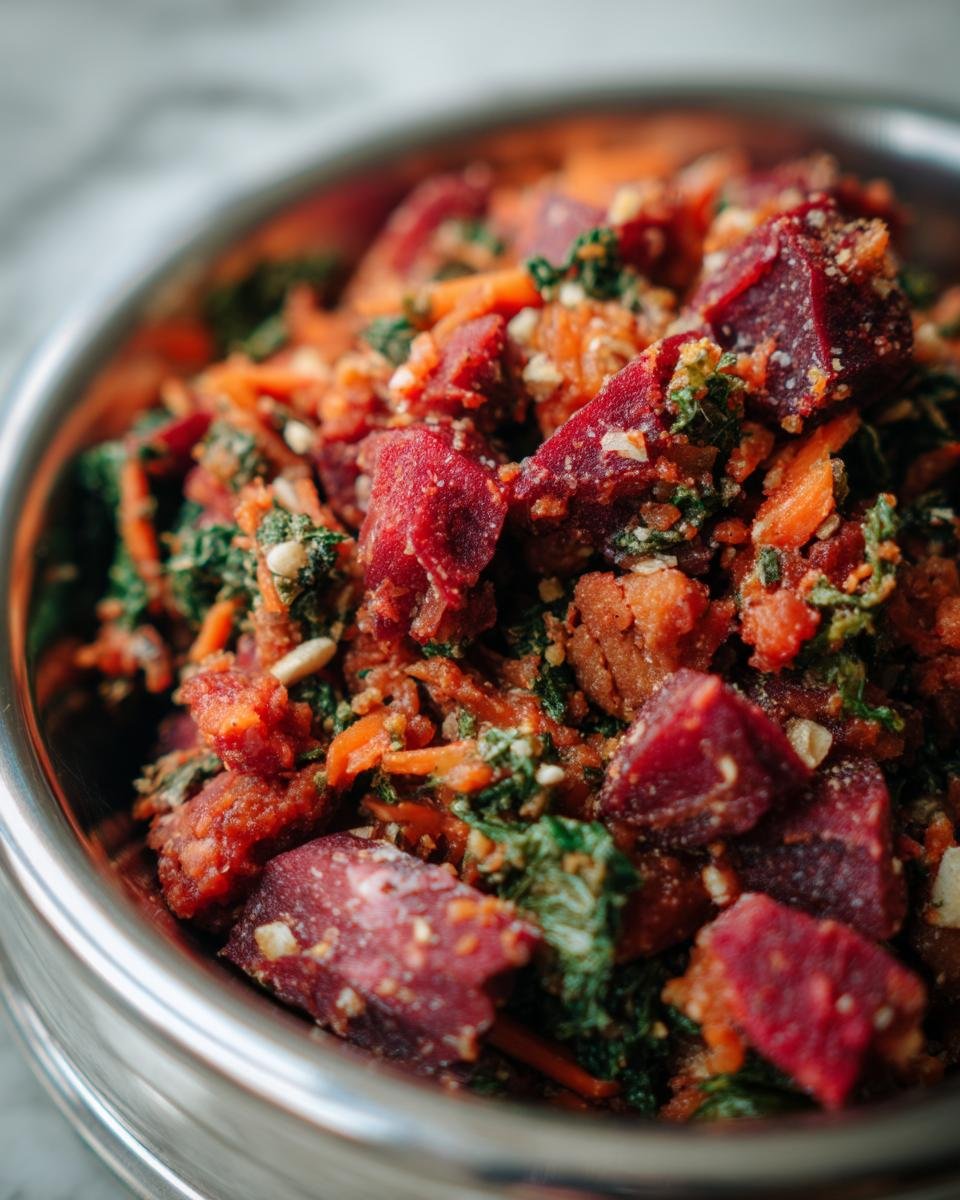
Ingredients for Optimal Nutrients in Raw Feeding
Let’s talk ingredients—because this is where the magic (and the nutrition) really happens. You don’t need anything fancy, just the right mix of real, raw food to support your pet’s health from nose to tail.
- 2 lbs raw muscle meat (beef, chicken, or turkey): This is the hearty base of the meal, packed with protein and essential amino acids. I usually go with chicken thighs or beef chunks—whatever’s fresh and affordable.
- 0.5 lbs raw organ meat (liver, kidney): Organs are nutrient powerhouses, especially liver, which is rich in vitamin A, iron, and B vitamins. Don’t skip this part!
- 0.5 lbs raw bones (ground or whole): Bones provide calcium and phosphorus—critical for strong teeth and bones. I use ground chicken backs or soft, raw necks (never cooked!).
- 0.25 cups vegetables (spinach or carrots): A little veg adds fiber and micronutrients. I chop them fine or lightly steam for better digestion.
- 1 tbsp fish oil (optional): For a boost of omega-3s that support a healthy coat and joints. My pup loves the taste, too.
- 1 tsp seaweed powder: This tiny scoop delivers iodine, which supports thyroid health. Just a little goes a long way.
With this combo, you’ve got a balanced, nutrient-rich meal that’s as close to nature as it gets.
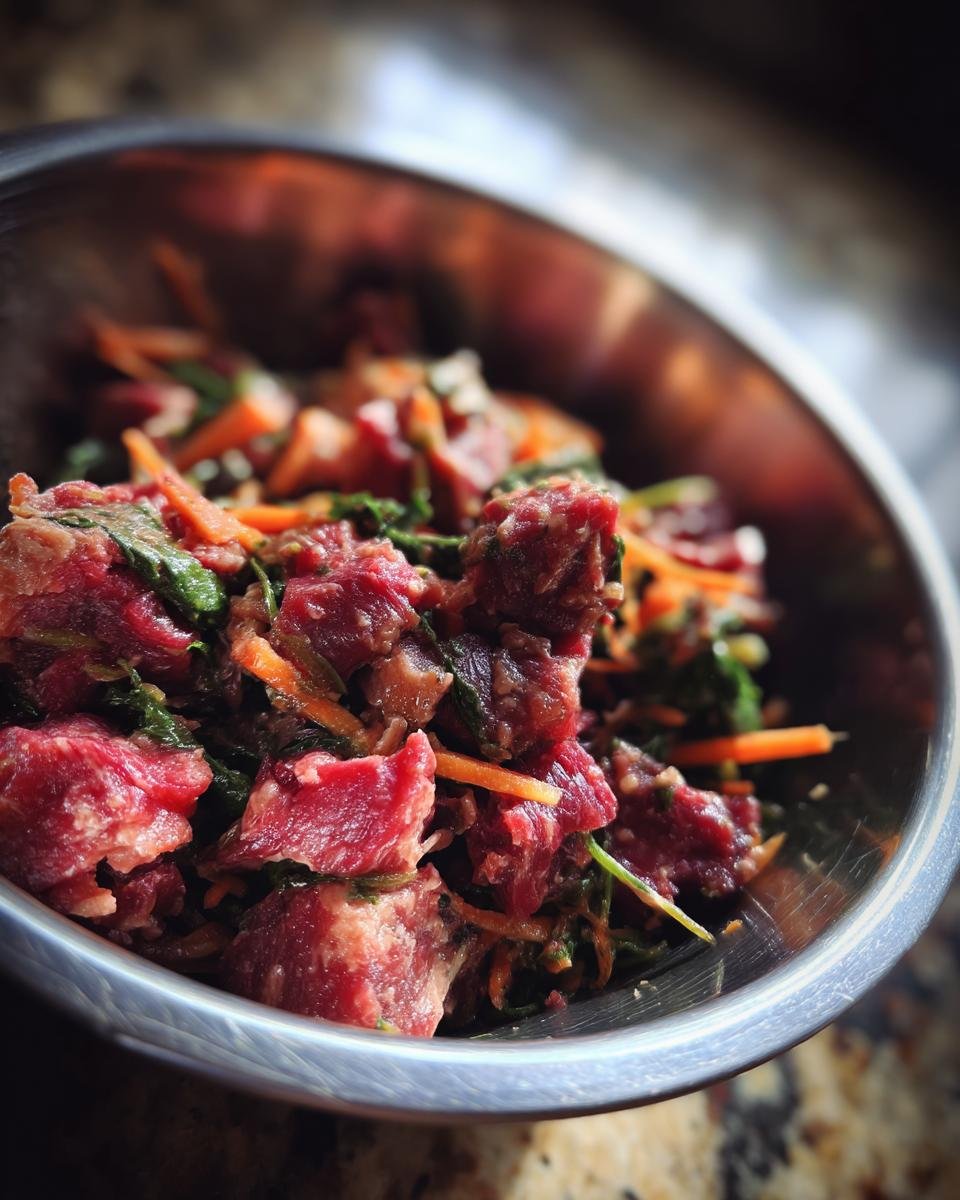
How to Prepare a Balanced Raw Meal
Okay, let’s get into the fun part—actually making the meal! Don’t worry, it’s easier than it sounds, and once you’ve done it once or twice, it becomes second nature.
Start by selecting fresh, high-quality ingredients. If you’ve just brought home meat from the store or butcher, go ahead and freeze it for at least 48 hours first—especially wild or game meats—to kill off any potential parasites. Safety first!
Once thawed, chop everything into manageable pieces based on your pet’s size. I like to use a food processor for veggies and organs, while I hand-cut muscle meat into chunks. Bones can be fed whole if they’re soft (like raw chicken necks), or ground up if you’re more comfortable with that.
Stick to the golden ratio: 80% muscle meat, 10% organ, 10% bone. Mix everything together in a large bowl, then portion into freezer-safe containers. Label them with the date and amount—it makes life so much easier later on!
Thaw each portion in the fridge overnight before serving. No microwaving—this is raw feeding, after all! And always clean your tools and surfaces thoroughly afterward. It’s a little messy, but totally worth it.
Why Nutrients in Raw Feeding Matter for Pets
When you feed your pet raw, you’re giving them nutrients the way nature intended—straight from unprocessed, whole foods. That means high-quality protein from real meat, which helps build strong muscles and keeps energy levels up. Organs bring in a flood of essential vitamins like A, D, and B-complex, while raw bones offer natural calcium and phosphorus for sturdy bones and teeth.
It’s not just about what’s in the bowl—it’s about what those nutrients do. I’ve seen better digestion, firmer stools (yes, we talk about poop here), glossier coats, and way fewer allergy flare-ups in pets on a raw diet. The nutrients in raw feeding support everything from immune health to joint mobility. It’s one of the easiest ways to help your dog or cat feel their best—inside and out.
Tips for Getting the Most Nutrients in Raw Feeding
Raw feeding isn’t just about tossing meat in a bowl—it’s about getting the most out of every ingredient. Here are a few tricks I’ve picked up that really make a difference in retaining all those amazing nutrients:
- Buy fresh, local meat when possible. The shorter the supply chain, the more nutrients stay intact. Butchers are your best friends here.
- Freeze meats for at least 48 hours before using, especially if it’s wild or game meat. It keeps your pet safe without sacrificing quality.
- Keep bones raw. Cooked bones can splinter and lose their nutritional value—plus, they’re a safety hazard.
- Add fish oil or seaweed powder for that extra boost of omega-3s and iodine. Just don’t overdo it—a little goes a long way.
- Prep in small batches to keep everything fresh. I portion and freeze meals weekly so vitamins stay potent and meals are easy to defrost.
With just a little planning, you’ll keep those raw meals packed with everything your pet needs to thrive.
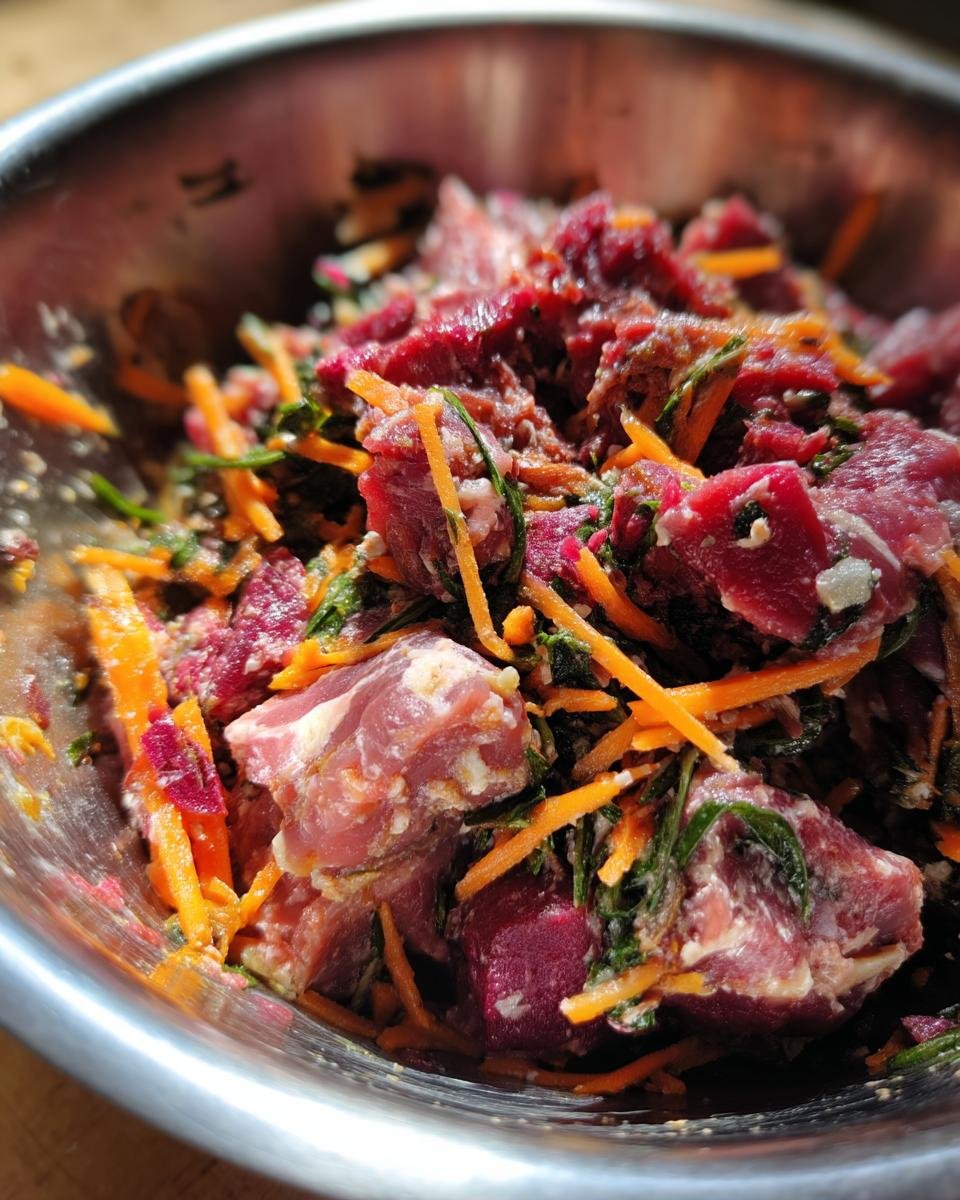
Ingredient Swaps Without Losing Nutrients in Raw Feeding
Don’t stress if you can’t find a certain ingredient—raw feeding is flexible as long as you keep the balance right. Variety is actually a good thing! It helps cover all the nutritional bases and keeps mealtime interesting for your pet.
- Swap chicken for turkey or beef depending on availability. Just stick to muscle cuts like thighs or chunks.
- Use lamb liver or chicken liver if beef liver isn’t available—each has a slightly different nutrient profile, but all are rich in vitamins.
- Spinach can be switched with kale or zucchini for veggies. Just chop or lightly steam them for easier digestion.
- Never skip the organ meat or bones—they’re vital for vitamins and minerals. If you’re missing one, wait to prep until you have the full trio.
Mixing things up now and then is not only okay—it’s encouraged. Just be sure every meal still hits that 80/10/10 balance, and you’re golden.
Common Questions About Nutrients in Raw Feeding
Is it safe to feed raw bones?
Yes—but only raw bones! Cooked bones can splinter and cause serious harm. Raw bones, like chicken necks or wings, are softer and digestible. I always supervise mealtime and choose bone sizes appropriate for my dog’s size and chewing style. If you’re nervous, ground bone is a great alternative that still delivers calcium and phosphorus safely.
How do I know if my pet is getting enough nutrients?
Good question! Signs like a shiny coat, steady energy, healthy weight, and firm stools usually mean you’re on the right track. For peace of mind, I check in with my vet every few months and occasionally run a blood panel. If you’re unsure, a pet nutritionist can help evaluate your raw diet for pets and suggest tweaks if needed.
Can I skip organs or seaweed powder?
Try not to. Organs (especially liver) are loaded with essential vitamins, and skipping them long-term can lead to deficiencies. Seaweed powder supplies iodine, which supports thyroid health. If you absolutely can’t find an ingredient, skip it temporarily and make sure to replace it as soon as possible.
What’s the best way to transition to raw feeding?
Slow and steady! Start by mixing a small amount of raw food with your pet’s current diet. Increase the raw portion over 7–10 days, watching for any digestive upset. Some pets need more time—especially seniors or those with sensitive tummies. And always introduce new proteins one at a time.
How often should I rotate proteins?
I aim to rotate every week or two. Switching between beef, chicken, turkey, or even lamb helps cover all amino acids and micronutrients. It also keeps your pet excited for mealtime! In canine nutrition, variety is key to balancing the full spectrum of nutrients in a raw diet.
Storage and Reheating for Raw Pet Meals
Once you’ve got your raw meals prepped, storing them properly keeps all those nutrients fresh and safe. I portion everything into freezer-safe containers or silicone molds and label them with the date and size (lifesaver when you’re groggy in the morning!). Most batches last about 3–4 days in the fridge once thawed, so I freeze the rest right away.
Always thaw meals in the fridge overnight—never on the counter. And don’t microwave or cook them! That defeats the purpose of raw feeding and can make bones dangerous. Unless your vet says otherwise, raw meals should be served cold or room temp. It takes a little planning, but it’s super easy once you’re in the groove.
Nutritional Information for Raw Feeding
Here’s a general snapshot of what one serving (about 1 cup) of a balanced raw meal might look like. Keep in mind these numbers can vary depending on the exact meats, organs, and extras you use—but this gives you a solid ballpark:
- Calories: 350
- Protein: 28g
- Fat: 25g
- Carbohydrates: 3g
- Cholesterol: 90mg
- Fiber: 1g
- Sodium: 120mg
I always say—treat this as a guide, not gospel. Small changes in cuts of meat or veggie amounts can shift things around a bit. That’s why variety and rotation are so important in raw feeding!
What to Do After Learning About Nutrients in Raw Feeding
Now that you’ve seen how doable (and rewarding!) raw feeding can be, why not give it a try? Make your first batch, snap a photo of your happy pup or kitty, and drop a comment below—I’d love to hear how it goes! Got questions? Ask away. I’m always here to chat raw diets, swap ideas, or troubleshoot. Let’s build a community of pet parents who feed with heart and confidence!
Print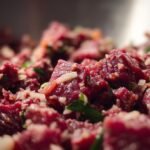
Nutrients in Raw Feeding Changed My Dog’s Life in 30 Days
- Total Time: 20 minutes
- Yield: 3-4 days of meals (adjust for pet size) 1x
- Diet: Low Lactose
Description
Raw feeding provides essential nutrients through unprocessed ingredients like meat, bones, and organs. This approach aims to mirror a natural diet, offering high-quality protein, vitamins, and minerals for optimal pet health.
Ingredients
- 2 lbs raw muscle meat (e.g., beef, chicken, turkey)
- 0.5 lbs raw organ meat (e.g., liver, kidney)
- 0.5 lbs raw bones (ground or whole)
- 0.25 cups vegetables (e.g., spinach, carrots)
- 1 tbsp fish oil (optional)
- 1 tsp seaweed powder (for iodine)
Instructions
- Select fresh, high-quality meats and organs from trusted sources.
- Balance ratios: 80% muscle meat, 10% organs, 10% bones.
- Chop or grind ingredients to manageable sizes for your pet.
- Mix in vegetables and supplements if using.
- Portion meals based on your pet’s weight and activity level.
- Store portions in freezer-safe containers; thaw before serving.
Notes
- Consult a veterinarian before starting a raw diet.
- Freeze meats for 48+ hours to kill potential parasites.
- Avoid cooked bones, as they splinter easily.
- Transition pets gradually to avoid digestive upset.
- Monitor weight and energy levels regularly.
- Prep Time: 20 minutes
- Cook Time: 0 minutes
- Category: Pet Food
- Method: Raw
- Cuisine: Pet Food
Nutrition
- Serving Size: 1 cup
- Calories: 350
- Sugar: 1g
- Sodium: 120mg
- Fat: 25g
- Saturated Fat: 8g
- Unsaturated Fat: 12g
- Trans Fat: 0g
- Carbohydrates: 3g
- Fiber: 1g
- Protein: 28g
- Cholesterol: 90mg

